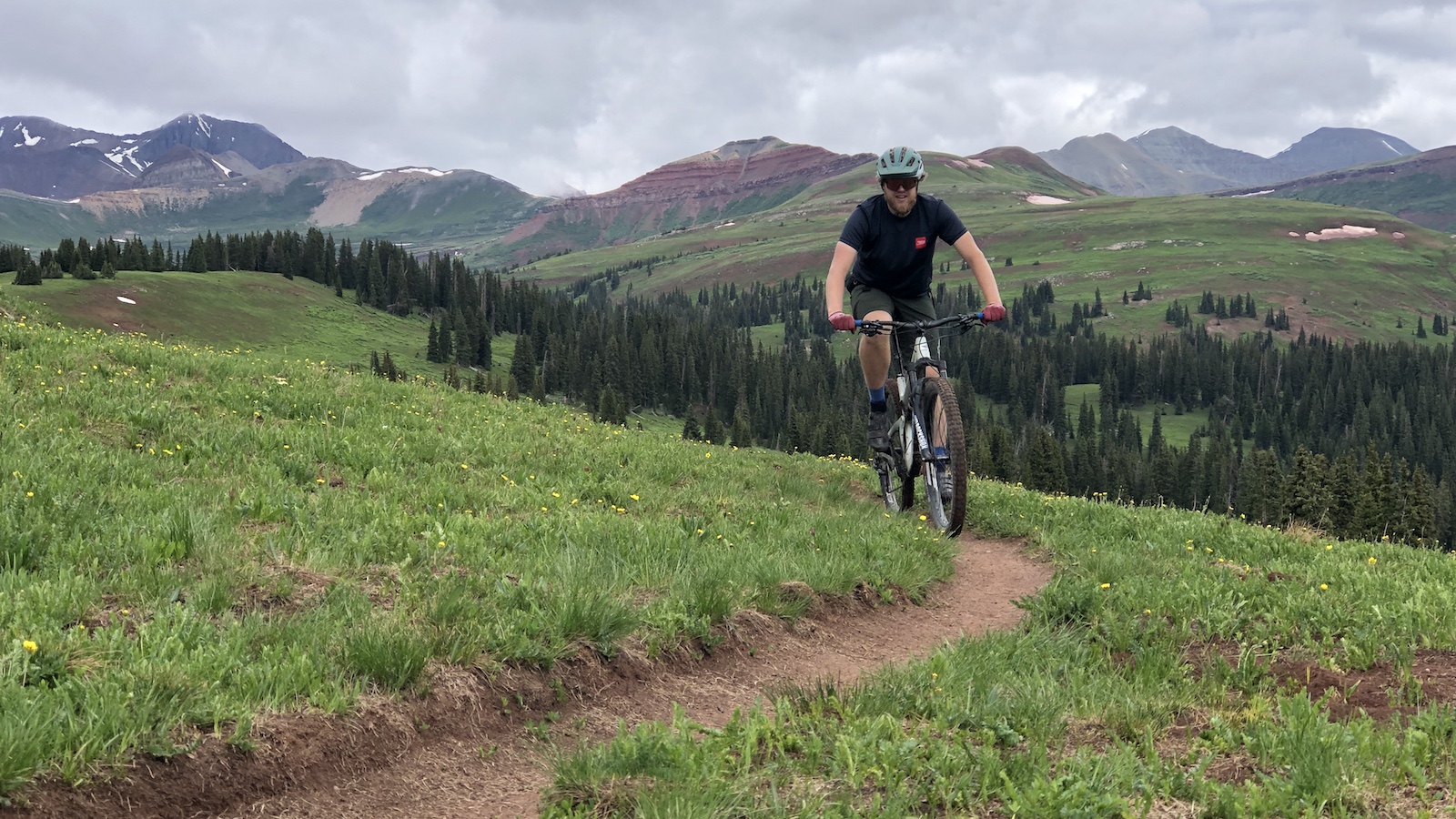


Imagine venturing into nature’s playground, where trails wind through dense forests, across rugged terrains, and over undulating landscapes. Singletrack mountain biking is not just a sport; it’s an exhilarating adventure that immerses riders in the heart of the wilderness.
At its essence, singletrack mountain biking refers to riding along narrow trails that accommodate only one rider at a time. These trails wind through natural terrain, often weaving between trees, skirting rock formations, and embracing the twists and turns of the landscape.
It’s an experience that takes riders off the beaten path and into the heart of nature’s beauty.
Its allure lies in its dynamic nature. As riders navigate the challenging twists and occasional technical sections, every moment is a dance between rider and terrain. The ever-changing landscape demands focus, skill, and an intimate connection with the bike.
In this article, we’ll delve deeper into the world of singletrack mountain biking, exploring its origins, the gear required, the techniques to master, and the exhilaration that comes with conquering these trails. So, saddle up and embark on a journey that promises not just adventure, but a profound connection with the wild beauty of the outdoors.
Read More: Can you Ride a mountain bike on Pavement
Key Features Of Singletrack



These trails are characterized by the unique features that set them apart from wider paths or roads. Here are the key features of these trails:
- Narrow Width:
These trails are intentionally narrow, often only wide enough for one rider to pass at a time. This narrow width creates an intimate connection with the surroundings and demands precision in riding.
- Natural Terrain:
These trails follow the contours of the natural terrain, winding through forests, hills, and various landscapes. They often incorporate the natural features of the environment, like rocks, roots, and dips.
- Technical Sections:
These trails frequently include technical sections such as tight turns, steep ascents, descents, and challenging obstacles. Negotiating these sections requires advanced riding skills and finesse.
- Twists and Turns:
These trails are known for their twists and turns, requiring riders to navigate tight corners and switchbacks. The constant changes in direction demand quick reactions and agility.
- Undulating Terrain:
The terrain on singletrack trails can vary greatly, with frequent elevation changes. This undulating terrain adds to the challenge and excitement of the ride.
- Single Lane:
As the name suggests, singletrack trails have only one designated path. This creates a sense of exploration as riders follow the defined route, avoiding deviation.
- Technical Features:
These trails often incorporate technical features like rock gardens, log crossings, and narrow bridges. These elements further enhance the challenge and diversity of the ride.
- Connection with Nature:
These trails provide an immersive experience in nature. Riders are surrounded by the sights, sounds, and scents of the outdoors, offering a unique way to connect with the environment.
- Physical and Mental Engagement:
Navigating singletrack trails requires a combination of physical stamina and mental focus. Riders must adapt to changing conditions, anticipate obstacles, and make split-second decisions.
- Skill Progression:
These trails offer a platform for skill progression. Novice riders can start with less technical sections and gradually build their abilities to conquer more challenging trails.
- Adventure and Exploration:
Riding singletrack trails fosters a sense of adventure and exploration. Each trail is an opportunity to discover new routes, overcome obstacles, and experience the thrill of the outdoors.
Overall, the key features of singletrack trails create a dynamic and engaging riding experience that challenges riders’ skills, immerses them in nature, and rewards them with a unique sense of accomplishment.
Read More: Is mountain bike good for beginners
Unveiling Singletrack Mountain Biking: Exploring the Essence and Allure
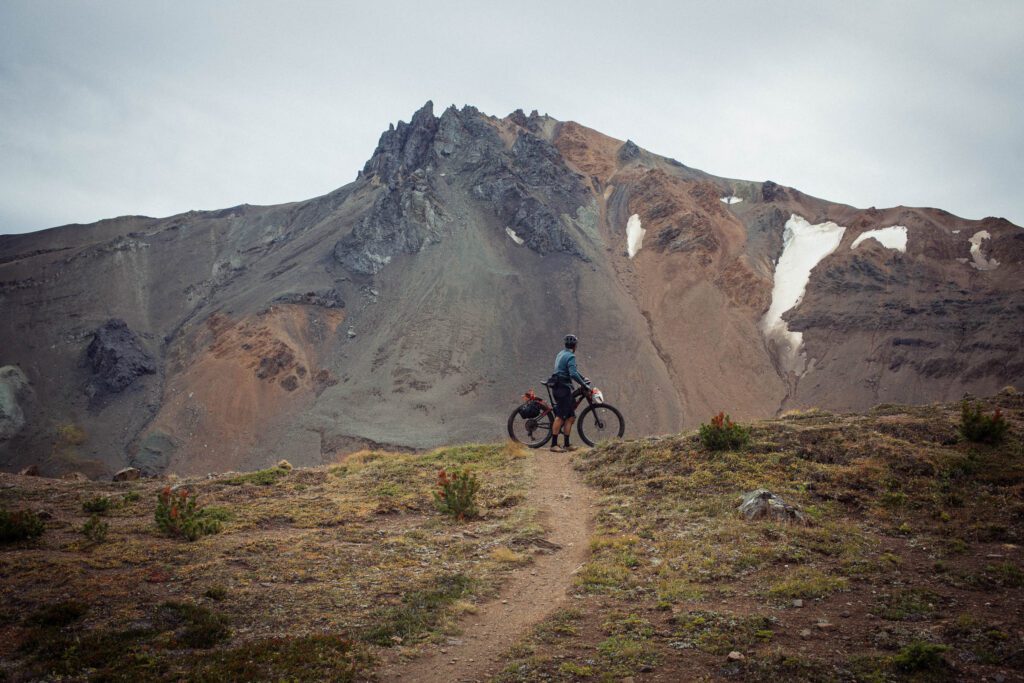


Imagine a world where narrow trails wind through forests, over hills, and around bends, offering an intimate connection with nature. This world is singletrack mountain biking, a thrilling adventure that transcends the ordinary and takes riders on a journey through the heart of the wild.
Read More : ” Stumpjumper Comp Alloy Weight “
What is Singletrack Mountain Biking?
Singletrack mountain biking involves riding on narrow trails designed for a single rider. Unlike wider paths, singletrack trails weave through diverse terrains, presenting a unique blend of challenges and rewards. These trails bring riders closer to nature, offering an immersive experience that ignites the senses.
The Allure of Singletrack Riding
- Close Encounters with Nature:
Singletrack trails guide riders through breathtaking landscapes, allowing them to experience nature up close. From dense forests to open meadows, the surroundings evolve with every twist and turn.
- Technical Engagement:
Negotiating the twists and turns of singletrack trails demands technical prowess. Riders must adapt to varying surfaces, gradients, and obstacles, enhancing their skills with each ride.
- Adrenaline Rush:
The ever-changing nature of singletrack trails keeps riders engaged and excited. The continuous shifts in terrain demand focus, ensuring a thrilling adventure with every ride.
Gearing Up for the Journey
- The Right Bike:
Choose a mountain bike designed for off-road adventures. A lightweight frame, sturdy tires, and efficient suspension are essential for tackling singletrack trails.
- Safety First:
Wear a helmet and appropriate protective gear. Gloves, knee pads, and elbow pads can provide extra protection during challenging sections.
Mastering the Art of Singletrack Riding
- Body Positioning:
Maintain a balanced stance on the bike, distributing weight evenly between the wheels. This improves stability and control, especially in technical sections.
- Cornering Techniques:
Lean the bike, not just your body, when navigating corners. This allows for better traction and control, reducing the risk of skidding.
The Ultimate Connection with Nature
Singletrack mountain biking isn’t just a sport; it’s a chance to immerse yourself in the world around you. As you ride these trails, you’ll discover that each turn offers a new adventure, each uphill climb brings a sense of accomplishment, and each downhill descent fills you with exhilaration.
In Conclusion
Unveiling the world of singletrack mountain biking is an invitation to explore the beauty of nature and challenge your limits. It’s an experience that pushes you to connect with the outdoors, embrace the thrill of the ride, and discover the essence of adventure in every trail you conquer.
So, saddle up, let your curiosity lead the way, and embark on a journey that promises not just exhilaration, but also a profound connection with the untamed beauty of the world.
Read More: Can you ride a dirt jumper on trail
Winding Trails and Wild Adventures: An Introduction to Singletrack Mountain Biking
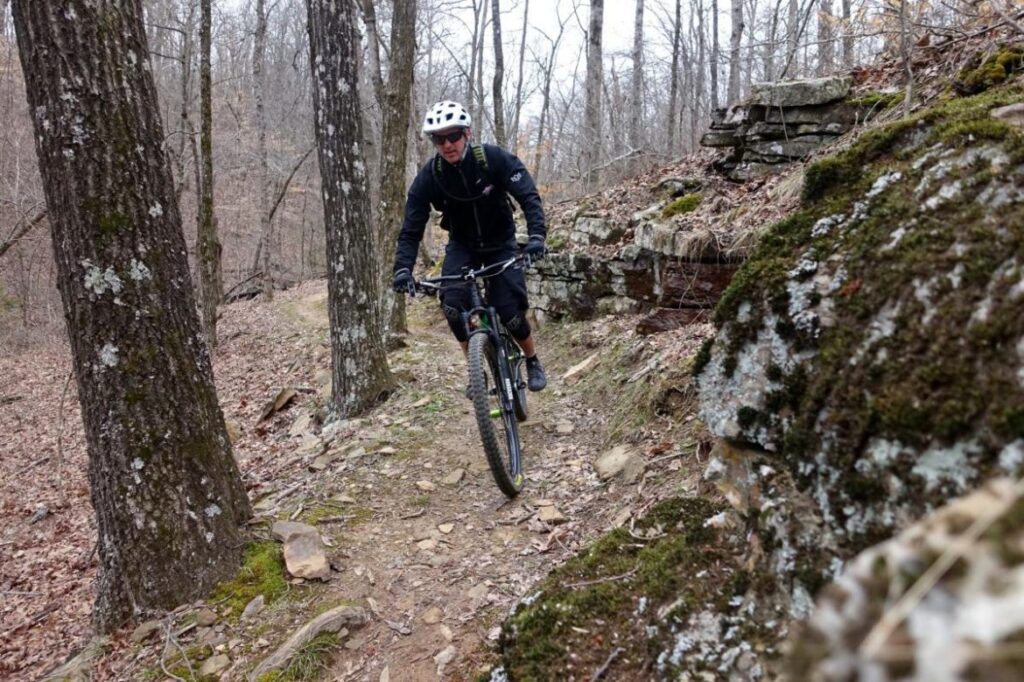


Amidst nature’s rugged terrain lies a thrilling world known as singletrack mountain biking. These winding trails, often no wider than a tire’s width, lead riders on exhilarating journeys through the heart of untamed landscapes.
In this article, we embark on an exploration of the dynamic realm of singletrack mountain biking, uncovering the essence of this captivating adventure.
The Essence of Singletrack Mountain Biking
- Trail Characteristics:
These trails are designed for one rider at a time, offering a more intimate connection with the environment. They twist and wind through diverse landscapes, creating an ever-changing riding experience.
- Nature’s Playground:
Unlike wider paths, singletrack trails delve deep into nature. They traverse forests, cross streams, and wind around rock formations, providing a front-row seat to the wilderness.
The Allure of the Trail
- Technical Challenge:
These trails demand skill and finesse. Riders navigate obstacles, switchbacks, and varying terrain, constantly refining their abilities with each ride.
- Adventurous Spirit:
The unpredictability of singletrack trails infuses every ride with a sense of adventure. Riders must adapt to changing conditions, making each journey unique.
Preparation and Gear
- The Right Bike:
Choose a mountain bike with appropriate features for off-road riding, such as sturdy tires, responsive suspension, and a durable frame.
- Essential Equipment:
Wear protective gear like helmets, gloves, and pads to ensure safety during challenging sections.
Mastering Singletrack Riding
- Body Positioning:
Maintain a centered stance on the bike, adjusting your weight for optimal control. This enhances stability and responsiveness on technical terrain.
- Cornering Techniques:
Practice leaning the bike, not just your body, when cornering. This technique enhances traction and minimizes skidding.
Nature’s Call and Your Response
Singletrack mountain biking invites you to embrace the outdoors and heed the call of nature. With each pedal stroke, you’ll discover the thrill of traversing hidden trails, conquering rocky paths, and immersing yourself in the elements.
Singletrack riding isn’t just about physical exertion; it’s about forging a connection with the land, mastering challenges, and experiencing the untamed beauty of the world in a truly unique way.
In Conclusion
As you embark on your journey through winding trails and wild adventures, remember that singletrack mountain biking is a fusion of nature and the human spirit. It’s a dance between rider and terrain, a pursuit that demands skill, tenacity, and a love for exploration.
So, equip yourself with determination, let curiosity guide you, and embark on a singletrack adventure that promises not just exhilaration, but also a profound connection with the captivating world around you.
Read More: Is biking good for knee pain
Riding the Uncharted: Understanding Singletrack Mountain Biking Trails



In the heart of the wilderness, a world of adventure beckons – the realm of singletrack mountain biking trails. These narrow pathways wind through untamed landscapes, promising an adrenaline-fueled journey that challenges and rewards.
In this article, we delve into the intricacies of singletrack trails, unraveling their essence and offering insight into the art of conquering the uncharted.
Decoding Singletrack Trails
- Trail Width and Character:
These trails are deliberately narrow, allowing only one rider to pass at a time. This design ensures an intimate connection with the surroundings, immersing riders in the natural beauty.
- Trail Features:
These trails are known for their diversity. They incorporate a mix of elements, from tight corners and steep climbs to technical descents and obstacles, offering a dynamic experience.
The Allure of the Trail
- Engaging Terrain:
These trails keep riders on their toes, demanding constant attention and agility. Negotiating rocks, roots, and sudden changes in terrain fosters skill development.
- Pure Adventure:
The unpredictable nature of singletrack trails fuels the adventure. Each trail presents a new challenge, encouraging riders to embrace uncertainty and test their limits.
Preparing for the Journey
- Suitable Bike:
Opt for a mountain bike designed for off-road terrain. Features like robust tires, suspension systems, and a sturdy frame ensure a comfortable and controlled ride.
- Safety Gear:
Prioritize safety by wearing a helmet, gloves, knee, and elbow pads. These protective elements shield you from potential hazards.
Navigating Singletrack Riding
- Body Position:
Maintain a balanced and centered stance on the bike. Distributing your weight evenly enhances stability, especially on technical sections.
- Cornering Techniques:
Practice leaning the bike while cornering, which improves traction and control. This technique minimizes skidding and ensures smoother turns.
The Trail’s Whisper and Your Response
Singletrack mountain biking is a dialogue between rider and trail, a dance of skill, instinct, and connection. The trail whispers its challenges, and you respond with finesse and determination. Every pedal stroke is a choice to engage with the uncharted, explore your limits, and savor the exhilaration of mastering the unknown.
In Conclusion
Understanding singletrack mountain biking trails is an invitation to embrace the wild and embark on a thrilling adventure. These trails are more than just pathways; they are gateways to discovery, self-improvement, and intimate communion with nature.
As you navigate through twists and turns, remember that singletrack riding is not only about conquering the trail but also about embracing the journey, cultivating your skills, and forging a lifelong bond with the untamed beauty of the outdoors.
So, saddle up, answer the trail’s call, and let the uncharted terrain become your canvas of exploration and triumph.
Read More: Can biking help lose belly fat
The Art of Trail Dance: Navigating the Beauty of Singletrack Mountain Biking
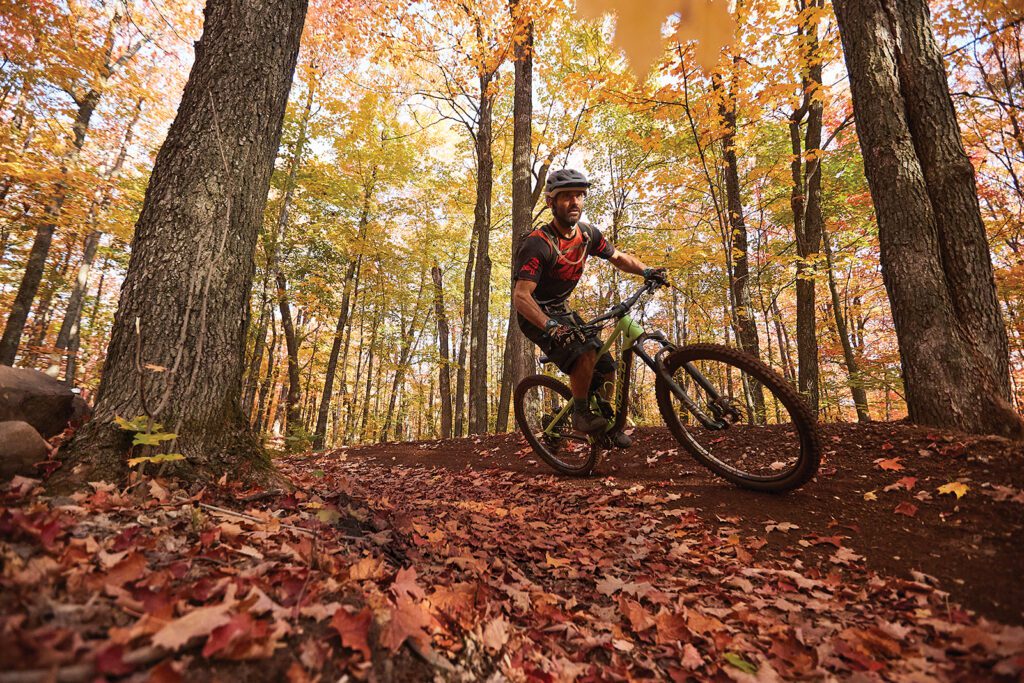


In the heart of nature’s canvas lies a dance of skill and exhilaration – the art of singletrack mountain biking. These winding trails offer a unique choreography, where riders become performers, responding to the rhythm of the terrain.
This article unveils the artistry of singletrack trail riding, exploring the techniques and finesse required to navigate the intricate steps of this captivating dance.
The Dance of Singletrack Trails
- Trail Symphony:
These trails are a composition of curves, dips, and obstacles that weave a symphony of challenge and allure. Each trail has its tempo and style, inviting riders to engage in a dance of movement and control.
- Dynamic Terrain:
Embrace the unpredictability of singletrack trails. From rocky ascents to swooping descents, each section demands your attention and mastery.
The Elegance of Trail Riding
- Fluid Body Movements:
Maintain a fluid and balanced body position on the bike. Slight shifts in weight and controlled movements enable you to glide through obstacles and curves with grace.
- Cornering Finesse:
Approach corners with finesse, leaning the bike and maintaining a balanced posture. This technique enhances traction, allowing you to conquer turns smoothly.
Preparation and Technique
- Mastering Momentum:
Utilize momentum to your advantage. Maintain a consistent pace to help you tackle inclines and navigate technical sections with greater ease.
- Trail Reading:
Develop the ability to read the trail ahead. Anticipate obstacles, shifts in terrain, and changes in direction to adjust your approach.
The Dance’s Connection
- Rider-Trail Bond:
These trail riding is a conversation between you and the trail. Your bike becomes an extension of your body, translating your intent into motion.
- Symbiotic Experience:
As you navigate the dance of singletrack trails, you become attuned to the natural world around you. Every curve, every challenge is an opportunity to connect with the outdoors.
The Art of Trail Dance: A Journey
The art of singletrack mountain biking is an ongoing journey, a dance that requires dedication, practice, and a deep appreciation for the trail’s nuances. With each ride, you refine your movements, enhancing your ability to harmonize with the ever-changing terrain.
In Conclusion
Navigating the beauty of singletrack mountain biking is an experience that transcends the ordinary. It’s about mastering the steps, embracing the rhythm, and forging a connection with the trail’s dynamic nature.
As you engage in this artful dance, remember that every trail is an invitation to create your unique masterpiece – a testament to your skill, passion, and unspoken dialogue with the trail itself. So, let your wheels become your partners, the terrain your stage, and the dance of singletrack mountain biking your masterpiece of adventure and finesse.
Read More: Specialized Rockhopper 27.5 review
Gearing Up for Singletrack Success: Essential Equipment and Preparation
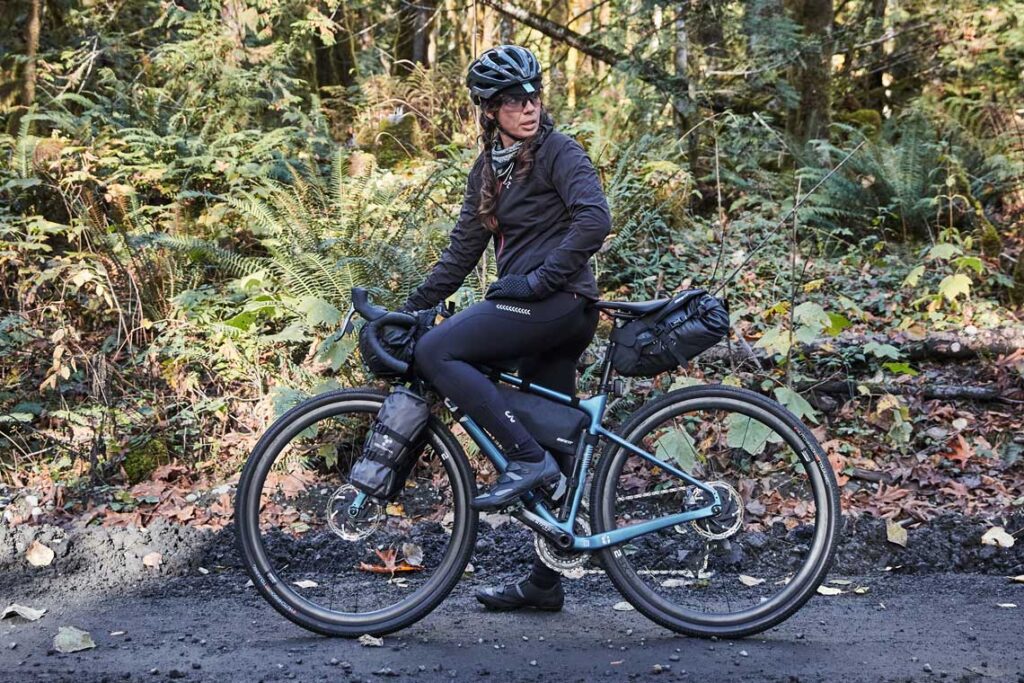


In the world of singletrack mountain biking, success begins long before the first pedal stroke. It starts with the right gear, meticulous preparation, and a deep understanding of what it takes to conquer challenging trails.
This article dives into the art of gearing up for singletrack success, offering insights into the essential equipment and thorough preparation required to navigate these exhilarating pathways.
Essential Gear for the Adventure
- The Right Bike:
Choose a mountain bike designed for off-road adventures. Look for features like responsive suspension, robust tires, and a durable frame to handle the demands of singletrack trails.
- Helmet and Protective Gear:
Prioritize safety with a well-fitting helmet. Additionally, consider wearing gloves, knee pads, and elbow pads to shield yourself from potential hazards.
Preparation: Your Path to Success
- Know the Trail:
Research and understand the trail you’ll be riding. Familiarize yourself with the elevation changes, technical sections, and potential challenges.
- Bike Maintenance:
Ensure your bike is in top condition. Check tire pressure, brakes, and gears to prevent any issues during your ride.
- Hydration and Nutrition:
Stay hydrated and energized by carrying a water bottle and snacks. Proper fueling is crucial for maintaining your stamina on the trail.
Mindful Approach to Riding
- Appropriate Clothing:
Wear moisture-wicking and breathable clothing that keeps you comfortable throughout your ride. Layering helps you adapt to changing weather conditions.
- Riding Essentials:
Pack a small toolkit with essentials like a spare tube, tire levers, and a multi-tool. Being self-sufficient on the trail ensures you’re prepared for any mishaps.
Preparing for the Unpredictable
- Trail Mapping:
Download trail maps or use GPS apps to help you navigate the trails. Having a visual guide enhances your confidence and prevents getting lost.
- Emergency Plan:
Share your riding plans with a friend or family member. Carry a fully charged phone and be aware of your surroundings to ensure your safety.
Setting the Stage for Success
Gearing up for singletrack success is about more than just equipment – it’s a mindset and a commitment to safety and preparedness. By understanding the trail, maintaining your bike, and carrying the right gear, you lay the foundation for an enjoyable and rewarding singletrack experience.
In Conclusion
As you embark on your singletrack adventure, remember that proper preparation is the key to unlocking the thrill and satisfaction of conquering challenging trails. By investing time in choosing the right gear and planning meticulously, you’ll set yourself up for singletrack success, enabling you to navigate the twists, turns, and obstacles with confidence, skill, and an undeniable sense of achievement.
So, gear up, embrace the challenge, and let your preparation become the launching pad for a trail-blazing journey filled with excitement and accomplishment.
Read More: How to ride switchback on a mountain bike
Mastering the Maneuvers: Techniques for Conquering Singletrack Trails
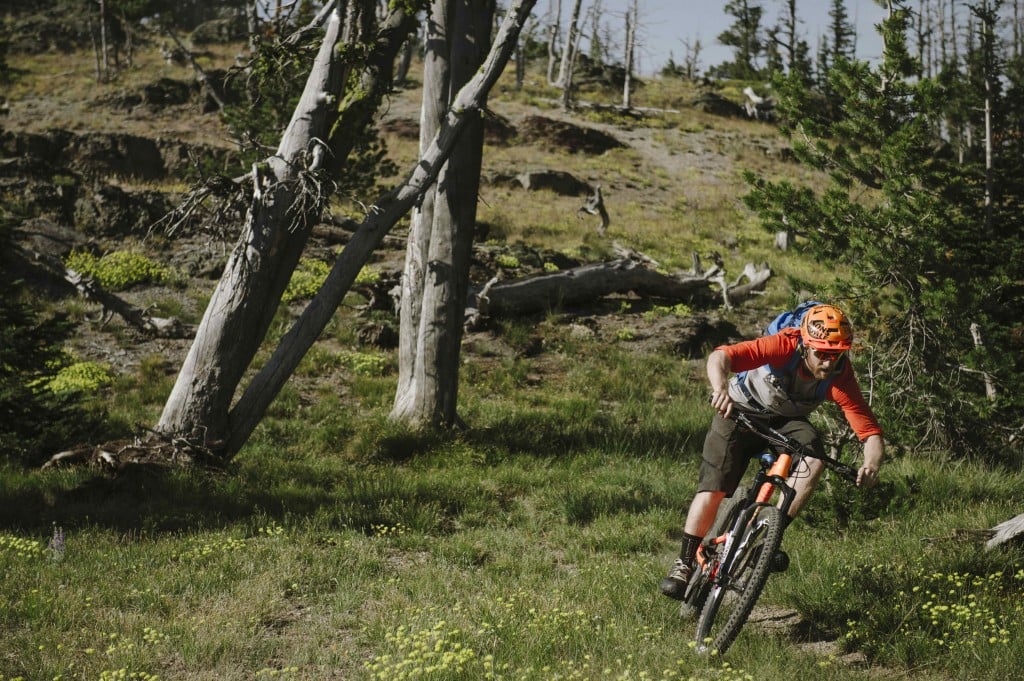


In the world of singletrack mountain biking, mastery lies not just in the equipment, but in the art of maneuvering through challenging terrains. These winding trails demand a repertoire of skills that empower riders to conquer obstacles, navigate tight corners, and ride with finesse.
This article delves into the techniques that are instrumental in mastering the maneuvers required to conquer singletrack trails.
Essential Techniques for Singletrack Success
- Balanced Body Position:
Maintain a centered stance on your bike, with your weight distributed evenly between the front and rear wheels. This promotes stability and control over changing terrain.
- Cornering Finesse:
Approach corners with precision. Lean your bike into the turn while keeping your body upright. This technique maximizes traction and prevents skidding.
Riding on Technical Terrain
- Climbing Skills:
When ascending steep inclines, shift your weight forward and keep your upper body relaxed. Use a controlled cadence to maintain momentum.
- Descending with Confidence:
When going downhill, shift your weight slightly to the rear, keeping your elbows and knees slightly bent. Use your body as a shock absorber to absorb impacts.
Navigating Obstacles
- Hopping and Lifting:
Learn to lift your front wheel to clear obstacles like rocks or roots. Master the bunny hop technique to tackle challenges with finesse.
- Drop-offs and Roll-Downs:
Approach drop-offs and roll-downs with control. Keep your weight centered and your eyes focused on the line you intend to ride.
Staying Safe and Agile
- Mindful Braking:
Use your brakes judiciously, applying both front and rear brakes simultaneously to avoid skidding. Brake before entering turns to maintain control.
- Efficient Gear Shifting:
Shift gears proactively to maintain an optimal pedaling cadence. Anticipate changes in terrain and shift accordingly to avoid gear crunching.
Progression and Practice
- Start Small:
Begin with less technical sections and gradually progress to more challenging terrain. Mastering foundational techniques is crucial before tackling advanced trials.
- Practice Consistently:
Regular practice hones your skills and builds confidence. Find opportunities to ride singletrack trails and refine your techniques.
Embarking on Mastery
Conquering singletrack trails is a continuous journey of growth and mastery. The techniques you develop not only enhance your riding experience but also enable you to navigate the most challenging terrains with finesse.
In Conclusion
As you navigate the world of singletrack mountain biking, remember that the art of mastering maneuvers is your gateway to conquering nature’s obstacles. By honing your skills in body positioning, cornering, obstacle navigation, and more, you’ll transform from a rider into a trail conqueror.
So, saddle up, embrace the challenge, and let your mastery of techniques become the guiding force that propels you through the twists, turns, and exhilarating ups and downs of singletrack trails.
Read More: How to make your mountain bike faster
Singletrack Symphony: How to Ride with Grace and Flow
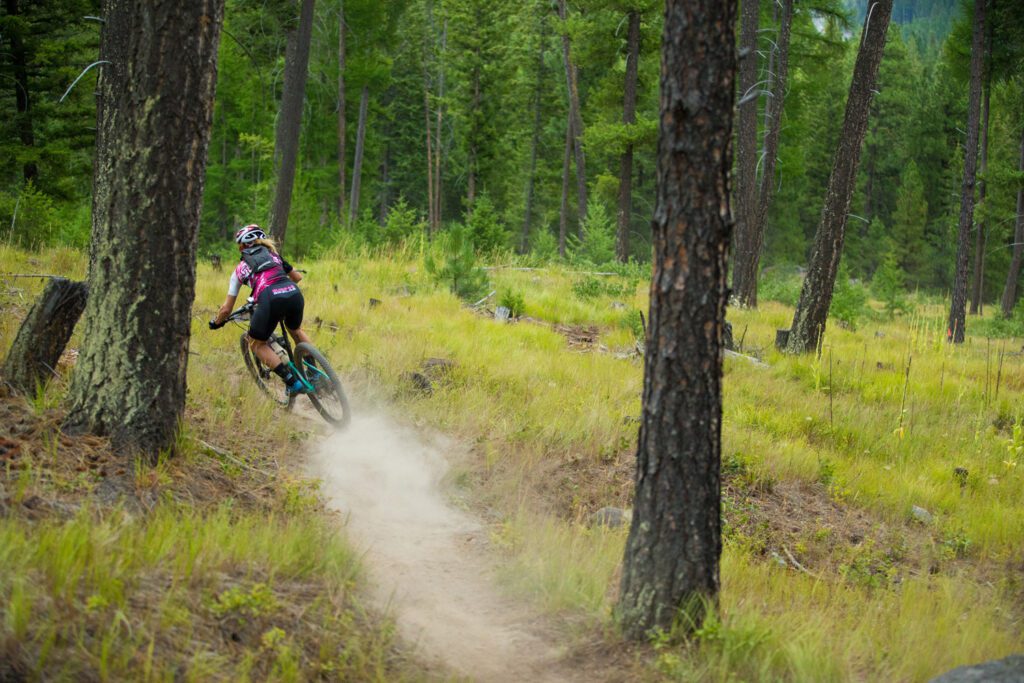


In the world of mountain biking, there’s a trail experience that goes beyond the technical and ventures into the realm of artistry – it’s the singletrack symphony. Picture yourself navigating narrow trails with seamless grace, flowing through twists and turns as if you’re dancing with the terrain.
This article delves into the essence of the singletrack symphony, unveiling the techniques that allow riders to achieve a harmonious blend of grace and flow on these captivating trails.
The Poetry of Singletrack Riding
- Embracing Fluidity:
These trails demand a rhythmic approach. Embrace a fluid riding style that allows you to adapt to the ever-changing terrain with finesse.
- Effortless Maneuvers:
Mastering balance and control enables you to navigate obstacles, turns, and descents seamlessly as if you’re an integral part of the landscape.
Techniques for Riding with Grace
- Smooth Cornering:
Approach corners with grace by leaning your bike while keeping your upper body upright. This technique maintains traction and minimizes friction.
- Elegant Climbing:
Ascend with poise by maintaining a steady cadence and distributing your weight effectively. Conquer inclines with a fluid pedal stroke.
Flowing Through Obstacles
- Obstacle Integration:
Instead of treating obstacles as disruptions, incorporate them into your flow. Lift your front wheel to glide over roots and rocks effortlessly.
- Balanced Descents:
Descend with finesse by shifting your weight backward and using your body as a shock absorber. Maintain balance to glide down with grace.
The Art of Visualization
- Trail Reading:
Develop the ability to anticipate the trail ahead. Visualize your line through corners, obstacles, and descents to seamlessly integrate them into your ride.
- Mental Rhythm:
Achieve a mental rhythm that syncs with the trail. Trust your instincts, and let your mind guide your body as you flow through the twists and turns.
Harmonizing with Nature
- Eco-Friendly Approach:
Ride responsibly to minimize trail impact. Flowing with grace also means respecting the environment and preserving trails for future generations.
- Immersive Connection:
The singletrack symphony isn’t just about riding; it’s about immersing yourself in nature. Listen to the whispers of the wind, the rustling leaves, and the rhythm of the trail.
Achieving the Singletrack Symphony
The singletrack symphony is a masterpiece of movement, technique, and connection. It’s about finding your rhythm, adapting to the melody of the trail, and expressing yourself through each twist and turn.
In Conclusion
As you embark on your journey to ride with grace and flow, remember that the singletrack symphony is a collaboration between rider and trail. By mastering techniques, refining your style, and connecting with nature, you’ll transform your rides into artistic expressions of movement and grace.
So, saddle up, embrace the rhythm of the trail, and let the singletrack symphony become your melody of adventure and harmonious connection with the world around you.
Read More: Can you ride a mountain bike on street
Conclusion:
In essence, singletrack mountain biking is an exhilarating dance with nature, a symphony of skill and nature’s challenges that unfolds on narrow, winding trails. As riders navigate through undulating terrain, tight corners, and technical features, they engage in a unique connection with both their bikes and the environment.
The very nature of singletrack trails demands precision, agility, and a keen sense of adventure.
This type of mountain biking isn’t just a sport; it’s an art form that bridges the gap between human prowess and the rugged outdoors. It’s a journey that unfolds on trails that wind through forests, over hills, and around bends, demanding riders’ finesse and engagement.
The dance of singletrack trails is where riders embrace challenges, conquer obstacles, and harmonize with the natural rhythm of the environment.
So, to answer the question “What is singletrack mountain biking?” – it’s a harmonious cooperation between rider and trail, a trip that transforms ordinary lifts into dynamic hassles with nature’s twists and turns.
It’s a symphony of skill and grace that unfolds on the canvas of undulating landscapes, inviting riders to experience the pure joy of conquering challenges and immersing themselves in the beauty of the outdoors.
FAQs:
What does single track mean in mountain biking?
In mountain biking, singletrack refers to a narrow trail, often just wide enough for one rider. It winds through natural terrain, providing an immersive and technical riding experience.
What is the difference between single and double-track?
Singletrack refers to narrow trails for one rider, offering technical challenges. Double-track is wider, accommodating two riders, often smoother and less technical, and suitable for beginners and recreational riding.
How do you ride a singletrack fast?
To ride singletrack fast, maintain a centered position on your bike, anticipate obstacles, and use controlled bursts of speed in open sections. Skillful cornering and efficient pedaling are crucial.
What are the advantages of single track?
Singletrack trails offer a more immersive and technical riding experience compared to wider paths. They enhance skills, provide natural challenges, and offer a deeper connection with the environment.
How to choose a mountain bike for beginners?
For beginners, choose a mountain bike with a comfortable fit, suitable frame size, and basic features. Consider a hardtail for versatility and a budget-friendly option. Test ride before purchasing.



Welcome to Bikegenics, where passion meets performance! We are a leading online destination for all things related to mountain biking, dedicated to providing you with top-notch gear, expert advice, and an immersive community to fuel your two-wheeled adventures. With a commitment to excellence and a deep love for the sport, we strive to elevate your biking experience to new heights.
